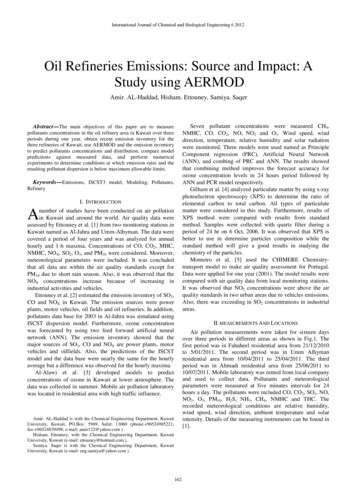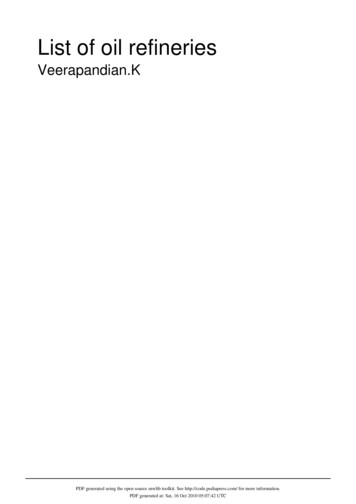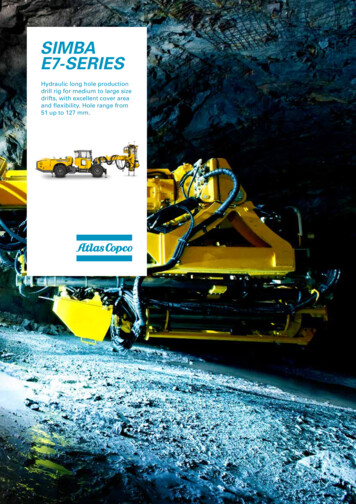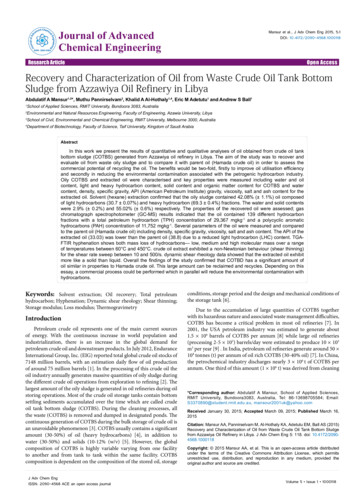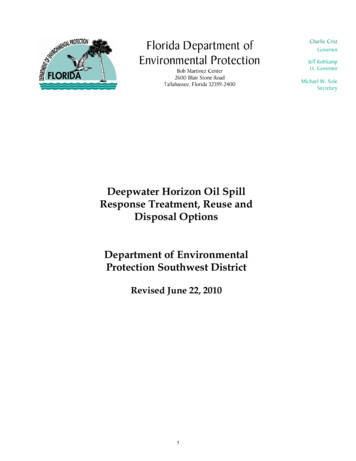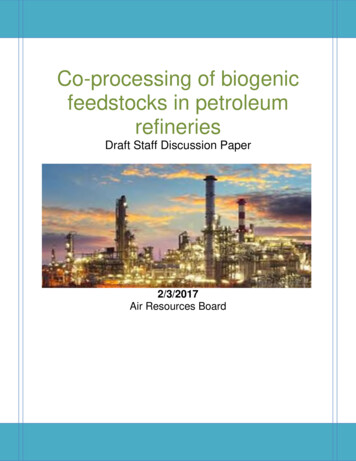
Transcription
HAZARDS IN OIL REFINERIES AND ITS SAFETYMouleeswarn T1, Vijay Babu K2PG scholar 1, Department of Mechanical Engineering, Excel College of Engg. and Technology,Komarapalayam, Tamilnadu.Associate Professor 2 , Department of Mechanical Engineering, Excel College of Engg. andTechnology, Komarapalayam, Tamilnadu.AbstractMost of the new of generation petroleum refineries possess high complexity indices, whichindicates their extensive conversion capabilities in terms of refining and improving the quality ofpetroleum product for global consumption. Because of the high demand for petroleum product yieldfrom the aforementioned processes, there is complexity in technology used in handling the processes.This complexity in technology also increases the complexity of petroleum refinery operations.In oil refineries, the concern for safety could be said to focus on two main areas; process safetyand personal safety. These two areas are very different from each other but both are important. Theyrequire two very different approaches to what one might call “the safety problem”. Process safetyinvolves the development and implementation of interventions concentrated on preventing orminimizing the effect of loss of containment of flammable, toxic, or reactive chemicals. Personal safetyinterventions focus on the prevention or mitigation of hazards that can result in individual injuries,exposures, or less catastrophic problem, but a no less important one.In this project, the data was collected through open-ended questionnaires from the workers inthe oil refinery. The questionnaire was administered to the workers randomly and was used to identifythe Health Hazards, determine the awareness of the workers of the Health Hazards and evaluate theOccupational Health Practice that exists in the Refinery.Keywords : Hazard Control, Safety, Hazardous,Petroleum Process.
1.INTRODUCTIONThe importance of occupational health is often overlooked and people tend to equate occupational illness withindustrialization and huge factories in urban areas. This narrow view hampered the development ofoccupational health in developing countries. While at work, people face a variety of hazards almost asnumerous as the different types of work, including chemicals, biological agents and adverse ergonomicconditions etc. Globally, there are 2.9 billion workers who are exposed to hazardous risks at their work places .Annually there are two million deaths that are attributable to occupational diseases and injuries while 4% ofGross Domestic Product (GDP) is lost due to occupational diseases and injuries. WHO‟s programme onworkers health is concerned with the control of occupational health risks, the protection and promotion of theworking populations and the humanization of work. Also work has its positive effect as increased productivity,higher quality work and increased workforce morale among others are indices of workers well being and tosome extend job satisfaction. However the importance of occupational health is often overlooked. This isbecause, the level of occupational safety and health in Africa is low compared with the rest of the world. InSub-Saharan Africa public health problems of child mortality, malaria, water quality and HIV/AIDS haveovershadowed occupational health problems. In today’s world, Man lives in a “chemical age” as there ishardly any industry that does not make use of it and/or produce chemicals in the work process. Petroleumproducts are derived from crude oil that occurs as a complex of chemicals, primarily hydrocarbons. Thisundergoes fractionalization to yield a variety of products forvarious uses. The petrochemical industry has been cited as a major pollution source, as the industrial processesinvolved ranged from prospecting for petroleum to refining of the crude and finally the arrival of the finishedproducts. The petrochemical workers are thus exposed to many and varied health hazards, accidents/injurieswith heavy tools and equipments, pipeline explosions, fire and transportation accidents and adverse ergonomicconditions etc. Risk factors leading to injuries are present in every work place. Among all occupations,industrial and agricultural workers have the highest risks.Therefore occupational health practice in the oil and gas industry must take cognizance of the known hazardsthat exists in the particular locale of operation in order to prevent and control their occurrence. To the best ofour knowledge, there has not been any recent study to identify and assess the health risk of occupational healthhazards of the refinery and petrochemical workers.The joint international labour organisation committee on occupational health, 1950, defined occupationalhealth as “the highest degree of physical, mental and social well-being of workers in all occupation.” A hazardis a source of danger that has the ability to cause injury or harm. Occupational hazards are dangers to humanhealth and well being which are associated with specific occupations. While efforts are made to reducehazards, these hazards remain present in the workplace by nature of the profession. Occupational or workplace
hazard is danger to health, limb, or life that is inherent in, or is associated with, a particular occupation,industry, or work environment. It includes risk of accident and of contracting occupational disease.The dictionary definitions do not correspond entirely with what epidemiologists or professionals in the field ofOccupational and Environmental Health would understand these terms to mean. Hazard is not deemed to besynonymous with risk although it can be an important determinant of risk. Although risk may be related to achance event and expressed as a probability, there is much more to it than that. Probability is not an entirelyhaphazard one of course but relates to a number of factors.However in Occupational and Environmental Epidemiology, we prefer to define these two words as follows:Hazard is the potential to cause harm; risk on the other hand is the likelihood of harm (in definedcircumstances, and usually qualified by some statement of the severity of the harm).The relationship between hazard and risk must be treated very cautiously. If all other factors are equal especially the exposures and the people subject to them, then the risk is proportional to the hazard. However allother factors are very rarely equal (Health, Environment and Work, October, 2013).Occupational hazards can be divided into two categories: Safety and Health Hazards. Safety Hazards thatcause accidents that physically injure workers, and Health Hazards which result in the development of disease.It is important to note that a hazard only represents a potential to cause harm. Whether it actually does causeharm will depend on circumstances, such as the toxicity of the health hazard, exposure amount, and duration.Hazard can also be rated according to the severity of the harm they cause – a significant hazard being one withthe potential to cause a critical injury or death (Ontario Ministry of Labour, October, 2013).Occupational hazards may lead to illness, injury or death. They can include physical risk like falls andexposures to heavy machinery, along with Psychosocial ones such as stress. Occupational hazards likeexposure to chemical, biological and radiological agents are also concern. In people who work in jobs withrecognised occupational safety hazards, special training is often provided so that the people are made aware ofthe hazard.2.RESEARCH METHODOLOGY2.1 DATA COLLECTIONStructured open-ended and self administered questionnaire was used to collect data on; socio-demographiccharacteristics of respondents, types of Occupational Health Hazards, awareness of the Health Hazard,knowledge of occupational illnesses and diseases and measures taken to prevent and/or control the risk pose byHealth Hazards on the workers. Qualitative data collection through questionnaire to determine the riskassociated with the hazards. Health Risk Assessment (HRA) Tool were carried out with a view to assess therisk associated with the Health Hazards identified. Consent to undertake the study was obtained through a
letter to the management and informed consent of the study participants who were assured of theconfidentiality of information collected.Questionnaire designThe questionnaire was designed in the following format: Strongly Agree (SA), Agree (A), Disagree (D) andStrongly Disagree (SD) rating such as 4, 3, 2 and 1 respectively assigned to the options. These questionnaireswere administered to workers of the Refinery.It is further divided into five subsections where multiple choice questions are set to identify the differentcategories of Health Hazards Physical Hazard Chemical Hazard Ergonomics Hazard Biological Hazard Psychosocial Hazard 4.2.2 METHOD OF DATA ANALYSISMicrosoft Excel was used to analyze the data obtained from the questionnaires to assess the risk on the HealthHazards data were presented using tables and charts. Descriptive statistical methods were also used to analyzethe data obtained from the questionnaires and their responses were recorded in a frequency table. Charts wereconstructed showing the respective percentages representing the respondents view on each question.Evaluation of respondents rating is made possible by the application of Kendall’s W statistic same as Kendall’scoefficient of concordance. Kendall’s Coefficient (W) is a non-parametric statistics.3.EXPERIMENTATION3.1 REFINERY PROCESSESThe physical and chemical transformations that crude oil undergoes in a refinery take place in numerousdistinct processes, each carried out in a discrete facility, or process unit. Large modern refineries comprise asmany as fifty distinct processes, operating in close interaction.3.1.1 CRUDE DISTILLATIONCrude oil distillation is the front end of every refinery, regardless of size or overall configuration. It has aunique function that affects all the refining processes downstream of it.
Crude distillation separates raw crude oil feed (usually a mixture of crude oils) into a number of intermediaterefinery streams (known as “crude fractions” or “cuts”), characterized by their boiling ranges (a measure oftheir volatility, or propensity to evaporate). Each fraction leaving the crude distillation unit It is defined by a unique boiling point range (e.g., 180–250 F, 250–350 F, etc. It is made up of hundreds or thousands of distinct hydrocarbon compounds, all of whichhave boiling points within the cut range. These fractions include (in order of increasing boiling range) light gases, naphthas, distillates,gas oils and residual oil Each goes to a different refinery process for further processing.The naphthas are gasoline boiling range materials; they usually are sent to upgrading units (foroctane improvement, sulfur control, etc.) and then to gasoline blending. The distillates, includingkerosene, usually undergo further treatment andthen are blended to jet fuel, diesel fuel and home heating oil. The gas oil go to conversion units, where they arebroken down into lighter (gasoline, distillate) streams. Finally, the residual oil (or bottoms) is routed to otherconversion units or blended to heavy industrial fuel and/or asphalt. The bottoms have relatively little economicvalue indeed lower value than the crude oil from which they come.Most modern refineries convert, or upgrade, the low-value heavy ends into more valuable light products(gasoline, jet fuel, diesel fuel, etc.). Because all crude oil charged to the refinery goes through crudedistillation, refinery capacity is typically expressed in terms of crude oil distillation throughput capacity.3.1.2 CONVERSION PROCESSConversion processes carry out chemical reactions that fracture (“crack”) large, high-boiling hydrocarbonmolecules (of low economic value) into smaller, lighter molecules suitable, after further processing, forblending to gasoline, jet fuel, diesel fuel, petrochemical feed stocks, and other high-value light products.Conversion units form the essential core of modern refining operations because they enable the refinery to achieve high yields of transportation fuels and other valuable light products. provide operating flexibility for maintaining light product output in the face of normalfluctuations in crude oil quality permit the economic use of heavy, sour crude oils. The conversion processes of primary interest are fluid catalytic cracking (FCC), hydro cracking and coking.
3.1.3 UPGRADING PROCESSUpgrading processes carry out chemical reactions that combine or re-structure molecules in low-value streamsto produce higher-value streams, primarily high octane, low sulfur gasoline blendstock. The upgradingprocesses of primary interest all employ catalysts, involve small hydrocarbon molecules, and apply to gasolineproduction.The most important of the many upgrading processes are catalytic reforming, alkylation, isomerization,polymerization and etherification.3.1.4 TREATING PROCESSTreating processes carry out chemical reactions that remove hetero-atoms (e.g., sulfur, nitrogen, heavy metals)and/or certain specific compounds from crude oil fractions and refinery streams, for various purposes. Themost important purposes are meeting refined product specifications (e.g.; sulfur in gasoline and diesel fuel, benzene in gasoline, etc.) protecting the catalysts in many refining processes from deactivation (“poisoning”) resulting from prolonged contact with hetero-atoms.By far the most widely-used of the various treating technologies is catalytic hydrogenation, or hydrotreating.Hydrotreaters remove hetero-atoms by reacting the refinery streams containing the hetero-atom(s) withhydrogen in the presence of a catalyst. The hydrogen combines with the hetero-atom(s) to form nonhydrocarbon molecules that are easily separated from refinery streams.Hydrotreating has many forms and degrees of severity; as a result, it goes by many names in the refiningindustry and in the literature. Hydrotreating focused on sulfur removal is often referred to as hydrodesulfurization; hydrotreating focused on nitrogen removal is called hydro-denitrification.Hydrotreating conducted at high severity (i.e., high temperature, pressure, and hydrogen concentration) ofteninvolves some incidental hydrocracking as well. Deep hydrotreating of this kind is called hydro-refining.Hydrotreating conducted at low severity is used to modify certain characteristics of specialty refined products(e.g., various lubricating oil properties) to meet specifications. Mild hydrotreating is often called hydrofinishing.
3.1.5 SEPARATION PROCESSVirtually all refinery streams are mixtures of hydrocarbon compounds. Separation processes use differences inthe physical and chemical properties of these compounds to separate one refinery stream into two or more newones.Distillation, or fractionation, the most common separation process, uses differences in boiling pointtemperatures to effect separations into relatively lighter (lower boiling) and relatively heavier (higher boiling)mixtures. Distillation employs well-established technology and is doubtless the most widely used refiningprocess; distillation units (fractionators) are ubiquitous in refineries.Distillation units require significant inputs of thermal energy, to boil the more volatile components of themixture being separated. Consequently, a refinery’s distillation units, including crude distillation collectivelyaccount for a significant fraction of the refinery’s total energy use.Extraction, another common separation process, uses differences in the relative solubilities of differentcompounds in a liquid solvent to remove specific compounds from hydrocarbon mixtures. The most commonrefining application of extraction is aromatics extraction, which selectively removes certain aromaticscompounds from the highly aromatic reformate stream produced in catalytic reforming . The extractedaromatics (benzene, toluene, and xylenes) are primary petrochemical feed stocks.3.1.6 UTILITIES AND SUPPORTING OPERATIONSRefineries encompass many additional process units of varying complexity and purpose. Some producespecialty products (waxes, lubricants, asphalt, etc.); others control emissions to air and water; and still othersprovide support to the mainline processes discussed above.The primary support facilities include: Hydrogen production and recovery Sulfur recovery (from desulfurization processes) Light gas handling and separation Wastewater treatment Oil movement and storage Electricity and steam generation Hydrocrackers and hydrotreaters require substantial inputs of hydrogen. As
noted above, some of the refinery hydrogen requirement (about 45% of the total in U.S. refineries) is met byby-product hydrogen produced in the reformer. The rest of the hydrogen requirement is met by on-purposehydrogen production units in the refinery or (in some locales) by purchases of hydrogen from near-bymerchant hydrogen plants.These units produce hydrogen from natural gas. Because on-purpose hydrogen is expensive, regardless of itssource, most refineries also have facilities for recovering and recycling the spent hydrogen in hydrocrackingand hydrotreating effluent streams.Refinery processes use fuel and steam to heat and/or boil process streams and to provide the energy needed todrive chemical reactions, and they use electricity for running pumps and compressors. Some refineriespurchase fuel (natural gas), electricity, and/or steam; others generate some or all of their utilities on-site. Onsite generation involves traditional steam boilers and power generation facilities, or co-generation. Cogeneration is the integrated production of electricity.3.1.7 PRODUCT BLENDINGProduct blending, the operation at the back end of every refinery, regardless of size or overall configuration,blends refinery streams in various proportions to produce finished refined products whose properties meet allapplicable industry and government standards, at minimum cost. The various standards pertain to physicalproperties (e.g., density, volatility, boiling range); chemical properties (e.g., sulfur content, aromatics content,etc.), and performance characteristics (e.g., octane number, smoke point).Production of each finished product requires multi-component blending becauseTypically, gasoline is a mixture of 6–10 blendstocks ; diesel fuel is a mixture of 4–6 blendstocks.Gasoline blending is the most complex and highly automated blending operation. In modern refineries,automated systems meter and mix blendstocks and additives. On-line analyzers (supplemented by laboratoryanalyses of blend samples) continuously monitor blend properties. Computer control and mathematical modelsestablish blend recipes that produce the required product volumes and meet all blend specifications, atminimum production cost. Blending of other products usually involves less automation and mathematicalanalysis.3.2 REFINERY PROCESSING UNITSPetroleum refineries processing units are large, continuous-flow production facilities that transform crude oilsinto refined products. Hence, to comprehend the details of petroleum refining processes it is important toconsider a refinery physical configuration and operating features. A refinery configuration defines the set ofprocess units, the capacity of the various units, their significant technical features, and the flow configurations
that link these units (John Rudill, 2005). Refinery process units are integrated as necessary to meet producttargets based on their capacity and configuration.The entire refinery consists of a number of processing units which include (OSHA, 1999; John Rudill, 2005):Crude Oil Distillation Unit (CDU): To separate crude oil into valuable distillates such as naphtha, kerosene,diesel, and other heavy components for further processes.Vacuum Distillation unit (VDU): For distillation to recuperate valuable gas oils from crude oil residue fromCDU via vacuum distillation.Hydrotreater unit: Desulphurize sulphur contaminant from unsaturated aromatics and olefins hydrocarbonsof crude oil to yield a clean product for advance processing or finished product.Catalytic Reforming unit: This unit produces high-octane reformate from desulfurized hydrocarbonmolecules for gasoline blending and also produce other petrochemical raw materials.Alkylation unit: This unit produces alkylate, a high-octane constituent of the end-product gasoline or petrolfrom butylene and isobutene.Isomerization unit: Transforms normal hydrocarbon molecules of low octane number into higher-octanebranched molecules for blending to finished product such as gasoline or petrol. Normal butane is converted tobranched isobutane in isomerization unit.Fluid Catalytic Cracking unit (FCC): FCC converts low gas oil from crude oil distillation to upgradedvaluable light product such as naphtha, diesel and slurry oil.Hydrocracker unit: Provides catalytic cracking and hydrogenation of heavy aromatic hydrocarbon fractionsfrom the crude oil distillation unit and the vacuum distillation units to produce light hydrocarbon products.Visbreaker unit: Convert heavy residual oils from the vacuum distillation unit into light product with lowerviscosity by thermal cracking process.Delayed coking and Fluid Coker units: This unit converts low value residual oils into lighter product such ascooker gas oil, diesel and naphtha by severe thermal cracking.3.3 REFINERY PRODUCTSRefined products produced in petroleum and gas refining may be classified into four categories: Lightdistillates, middle distillates, heavy distillates and others.Light distillates includes Liquid petroleum gas (LPG) ,Gasoline (or petrol) Kerosene and Jet fuel.Middle distillates includes Automotive and rail diesel fuels and other residential heating fuel and light fuel o
Fig 2.1 Flow diagram of oil refinery operation
4. RESULTS AND DISCUSSIONOccupational Health icalFigure TotalPercentage of Occupational Health 7286.791004.1 PERSONAL SAFETY PRECAUTIONOccupational Health and Safety Management System (OHS-MS) amongst Leadership and Commitment,Policy and Strategic Objectives, Organization, Responsibilities, Resources, Standards and Documents,Planning and Procedures, Implementation and Monitoring, Audit and Review is recommended managementprotocol that would assist an Oil and Gas Refinery Management protects, promotes and rehabilitates the healthand well-being of their workers. Consequently, three main strategies are used to achieve OHS-MS which areHealth Promotion, Protection and Rehabilitation in the workplace.1. Health ProtectionElimination: using a hazardous material from use in the workplace so that no further exposure is possible.Substitution: replacing a very hazardous material with a less hazardous one.Modification: changing a process or procedure to eliminate or reduce emissions.Containment: using physical barrier or containment to separate materials or environment from work areas.
Ventilation: removing or diluting hazardous materials in the air by removing the contaminated air andreplacing it with outside air.Workplace Practice: Work practices are procedures that limit worker exposure by reducing exposure times orkeeping workers away from contaminants. The following are some common work practices; Scheduling, GoodHousekeeping and Personal Hygiene Practices, Policies and ProceduresPersonal Protective Equipment (PPE): Equipment such as gloves and goggles are used to protect workers fromhazards. PPE is less effective because the hazard is still present and workers are not protected if the PPE fails.PPE should only be used if necessary after other control measures are implemented or if other controls are notpracticable.2. Health PromotionHealth Risk Assessment which is a management tool that allows the workplace comply with her occupationalpolicy, helps the workers do their jobs without damage to their health, enables the workplace meet her legalresponsibilities, enables the workplace show due diligence in the protection and promotion of the health of theworkers, provides an auditable platform and involves the work force in protecting the health of the workers.Biological Monitoring/Medical Surveillance that involves periodic medical examination including preemployment medical examination, health assessment and biological test. Sickness absence monitoring,reporting of occupational diseases and illnesses and ethical and legal issues.TrainingPhysical Activities2. Health RehabilitationImmediate Support and Initial Administrative ProcessesDuty of Care - Safe Return Home after InjuryBook Keeping and Reporting Injuries/IllnessesEffective Early Communication4.2 PROCESS SAFETY PRECAUTIONIn case of leakage of Hydrogen Sulphide, the leakage area must be evacuated immediately and allowed to enterthose employees who are wearing appropriate protective clothing and equipment to correct the problem.Management authority must implement effective rescue and exposure control plans in case of leakage ofhydrogen sulphide. There should be proper training programs for employees and supervisors. The engineering controls and safety work procedures should be properly implemented while utilizing personalprotective equipment in the function of drilling.
The hazardous material survey and risk assessment programs for mercury must be conducted by managementauthority frequently. The information related with this must be kept on site and communicated to allcontractors who will work at these sites. There should be engineering controls over the diesel exhaust by installing oxidation catalysts and exhaustfilters and utilization of low sulphur fuels or special fuel additives. There must be restriction on the dieselpower machinery in a work area and designate areas that are off limits for vehicles and engine relatedactivities. In order to provide safety to the workers who are related to the functions of maintaining and cleaningequipment and tanks or vessels which are polluted by radioactive materials, written radioactive materialsmanagement programs should be developed and implemented in the company. A program of hazard assessment must be conducted by management authority for every enclosed workingspace work. Management authority must prepare and implement a program for enclosed work area which mustbe included written safe work procedures for entry and regarding work procedure in every enclosed work area. In case of hazardous noise, there should be annual hearing test programs to determine the success of hearingconservation efforts. It is important to review test results and to impart training to employees regarding theexposure risk to hazardous noise. Apart from the above remedies, political leaders of oil and gas producing countries should support diseases.Injury prevention research and studies in the field of occupational health in general. Products containing highly toxic elements should be avoided and other alternatives should be used. Training for workers regarding personal hygiene and health should be promoted with emphasizing thenecessity for maintaining high standards of personal health and hygiene. There should be frequency in the disposal of oil products wastages. There should be cooperation among the oil producing countries regarding the elaboration and clarification ofexposure limits for petroleum products and components of petroleum products in water and entireenvironment. It is necessary to understand the elements responsible for the production of oil mists and thesignificance to health of inhalation of particles of various sizes.5. CONCLUSIONThe oil and natural gas sector has a significant place in the world’s economy. This sector is expanding rapidlyand providing many new job opportunities; but at the same time there is a increasing risk of work relatedfatality, injury and diseases.
In all segments, many chemical products are used and also produced. The employees exposed to chemicalsand gases produced in the oil and gas companies. It develops occupational diseases of the lungs, skin and otherorgans if employees are associated for a longer period with these chemicals. The employees of oil and GasCompany are associated with poorer psychosocial wellbeing or health, this is to say that the employees tend toexperience high level of stress and depression, dissatisfaction towards job and also sleep disorders.Occupational diseases usually develop over an extended periods of time. They are slow and generallycumulative in their effects, are irreversible and often complicated by non-occupational factors. Occupationaldiseases not only affects the health of the employee but also affects their family and social life, which includesunsatisfactory or disharmony marital life and cumulative stress trauma. Due to severe diseases employee keephimself away from his children and spouse.A positive health and safety organisational culture is underpinned by strong leadership by managementtogether with the active involvement and participation of workers in which everyone accepts their rights, rolesand responsibilities in relation to health and safety, and works collaboratively to prevent ill-health and injury,and to promote health and wellbeing. The commitment to effective worker participation needs to be visibleand communicated to the entire workforce. An effective safety and health management system should bebased on risk assessment, with the objective of identifying key occupational hazards and key at-risk groupsand developing and implementing appropriate prevention measures. Effective worker participation andemployee involvement in risk assessment and planning, and introducing measures is particularly important.REFERENCES1. Abdolhamidzadeh, B., Abbasi, T., Rasht
the oil refinery. The questionnaire was administered to the workers randomly and was used to identify the Health Hazards, determine the awareness of the workers of the Health Hazards and evaluate the Occupational Health Practice that exists in the Refinery. Keywords : Hazard Control, Safety, Hazardous,Petroleum Process.
